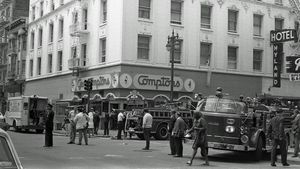Treatment GuideJust DiagnosedSex & DatingAfrican AmericanStigmaAsk the HIV DocPrEP En EspañolNewsVoicesPrint IssueVideoOut 100
CONTACTCAREER OPPORTUNITIESADVERTISE WITH USPRIVACY POLICYPRIVACY PREFERENCESTERMS OF USELEGAL NOTICE
© 2025 Pride Publishing Inc.
All Rights reserved
All Rights reserved
By continuing to use our site, you agree to our Privacy Policy and Terms of Use.
Some of the most important scientific advances regarding HIV are presented at a meeting called the Conference on Retroviruses and Opportunistic Infections, which I attended in February. This annual event draws the world's leading researchers and is a forum for discussion of HIV treatment and prevention advances'and challenges. One big AIDS story this year was about black men on the 'down low,' or DL. This is a new name for an old behavior among some men of all races'guys who define themselves as heterosexual but who also have sex with other men. They don't always tell their partners'male or female'about that behavior. Unfortunately, there are only sensationalized media stories about DL men and no real data about the extent of their risk or their partners' risk for HIV. At the retrovirus meeting Centers for Disease Control and Prevention scientist Greg Millett discussed the need for more facts about this population of men who have sex with men. His main point: We don't have any real numbers about how many men are on the DL or how safe (or not) they're being'just media hype. Don't get me wrong'DL behavior is real. But we won't know how widespread it is until new research takes a better look at this type of sexual behavior. The meeting's other big story concerning African-Americans was based on a small study of men in North Carolina colleges that compared their sexual behavior with that of men of the same age who were not in college. In both groups'and regardless of whether or not they had HIV'high-risk behavior was very common. Four out of 10 HIV-positive college students reported having casual unprotected sex with a male partner, compared to one third of HIV-negative students and one quarter of HIV-negative men who were not in school. What's most troubling about this study is that despite having had casual unprotected sex, only two of the 53 men in the entire study said they thought they were likely to get infected. This data is consistent with another study released by the CDC in 2002 in which the majority of young black HIV-positive gay men neither knew they were infected nor thought they were at risk of infection. AIDS has been around for 20-plus years. How can this be? Many AIDS organizations and universities have pulled back prevention efforts on college campuses. What we consider 'basic' facts about transmission may no longer actually be taught. If young black men'and women too'are to have sex safely and responsibly, or delay the onset of sexual activity, we must go back to school with AIDS 101. And we need to create a climate that encourages people to be honest with one another about their sexual desires and behavior. Demonizing people with HIV is not an effective prevention strategy. With African-Americans accounting for more than half of all new HIV infections in this country, AIDS strikes us way out of proportion to our numbers. Sixty percent of us know someone who has died of AIDS. The rate of African-American men with AIDS is eight times the rate of white men. For African-American women, it's 20 times that of white women. A recent study of U.S. HIV infections found that three quarters of heterosexual HIV infections are among African-Americans. As the founder of the nation's first and only think tank devoted to HIV and people of African descent, I spend almost every hour of every day talking about or thinking about AIDS. It's my belief that a lot more of us need to be doing so to stop the epidemic from ravaging our people. Wilson is the director of the Los Angeles'based Black AIDS Institute.
From our Sponsors
Most Popular
“So much life to live”: Eric Nieves on thriving with HIV
September 03 2025 11:37 AM
Thanks to U=U, HIV-positive people can live long, happy, healthy lives
July 25 2025 2:37 PM
The Talk: Beyond the exam room
August 13 2025 3:15 PM
BREAKING: Supreme Court rules to save free access to preventive care, including PrEP
June 27 2025 10:32 AM
Messenger RNA could be the key to an HIV vaccine — but government cuts pose a threat
August 20 2025 8:02 AM
“I felt like a butterfly”: Niko Flowers on reclaiming life with HIV
July 23 2025 12:22 PM
Dancer. Healer. Survivor. DéShaun Armbrister is all of the above
July 02 2025 8:23 PM
The Talk: Starting the conversation
July 25 2025 4:47 PM
The lab coat just got queer
August 21 2025 10:00 AM
Plus: Featured Video
Latest Stories
HIV-positive men stage 'Kiss-In' protest at U.S.-Mexico border
December 01 2025 12:56 PM
What the AIDS crisis stole from Black gay men
December 01 2025 6:00 AM
Amazing People of 2025: Javier Muñoz
October 17 2025 7:35 PM
It’s National PrEP Day! Learn the latest about HIV prevention
October 10 2025 9:00 AM
“I am the steward of my ship”: John Gibson rewrites his HIV narrative
September 16 2025 2:56 PM
The Talk: Owning your voice
August 25 2025 8:16 PM
The Talk: Navigating your treatment
August 01 2025 6:02 PM
How the Black AIDS Institute continues to fill in the gaps
July 25 2025 1:06 PM
1985: the year the AIDS crisis finally broke through the silence
June 26 2025 11:24 AM
VIDEO: A man living with HIV discusses his journey to fatherhood
June 10 2025 4:58 PM
Trump admin guts $258 million in funding for HIV vaccine research
June 03 2025 3:47 PM
Grindr is reminding us why jockstraps are so sexy and iconic
May 02 2025 5:36 PM
HRC holds 'die-in' to protest Trump health care cuts
April 28 2025 2:11 PM
Two right-wing Supreme Court justices signal they may uphold access to PrEP and more
April 21 2025 4:10 PM
500,000 Children at Risk: PEPFAR Funding Crisis
April 08 2025 3:51 PM
Broadway's best raise over $1 million for LGBTQ+ and HIV causes
April 03 2025 7:15 PM
The Talk Season 5 premieres this spring with HIV guidance for the newly diagnosed
March 26 2025 1:00 PM








































































